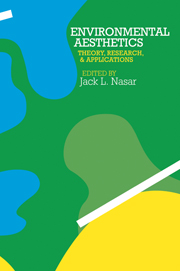Book contents
- Frontmatter
- Contents
- List of figures
- List of tables
- List of contributors and participants
- Acknowledgments
- Preface
- Section I Theory
- Editor's introduction
- 1 Behavioral and perceptual aspects of the aesthetics of urban environments
- 2 Symbolic aesthetics in architecture: toward a research agenda
- 3 Prospects and refuges revisited
- 4 Perception and landscape: conceptions and misconceptions
- 5 Where cognition and affect meet: a theoretical analysis of preference
- 6 The landscape of social symbols
- 7 Open space in cities: in search of a new aesthetic
- 8 Aesthetic perception in environmental design
- Section II Empirical studies
- Section III Applications
- References
- Index of authors
- Subject index
4 - Perception and landscape: conceptions and misconceptions
Published online by Cambridge University Press: 05 September 2013
- Frontmatter
- Contents
- List of figures
- List of tables
- List of contributors and participants
- Acknowledgments
- Preface
- Section I Theory
- Editor's introduction
- 1 Behavioral and perceptual aspects of the aesthetics of urban environments
- 2 Symbolic aesthetics in architecture: toward a research agenda
- 3 Prospects and refuges revisited
- 4 Perception and landscape: conceptions and misconceptions
- 5 Where cognition and affect meet: a theoretical analysis of preference
- 6 The landscape of social symbols
- 7 Open space in cities: in search of a new aesthetic
- 8 Aesthetic perception in environmental design
- Section II Empirical studies
- Section III Applications
- References
- Index of authors
- Subject index
Summary
It would seem that the psychology of perception should have something useful to contribute to landscape aesthetics. Certainly, students of landscape aesthetics make assumptions about the nature of perception. Although certain of these favorite assumptions are probably false, there was a time when it was not obvious that the psychology of perception had anything better to offer. Fortunately, a number of recent developments shed considerable light on the significance and functioning of the aesthetic reaction to landscapes.
From the perspective of landscape aesthetics, perhaps the single most salient theme in recent work in perception is what Gibson (1977) has labeled “affordances.” An affordance refers to what a perceived object or scene has to offer as far as the individual perceiver is concerned. Perception is viewed as not merely dealing with information about the environment, but also yielding information about what the possibilities are as far as human purposes are concerned. In addition to Gibson's contribution to this topic, this emphasis on the function that an object or environment might serve for the perceiver has appeared in the work of Gregory (1969) and S. Kaplan (1975).
One can go a step farther than the perception of affordances per se. As Charlesworth (1976) has pointed out, a species not only has to be able to recognize the sorts of environments in which it functions well, but also has to prefer them. Animals have to like the sort of settings in which they thrive.
- Type
- Chapter
- Information
- Environmental AestheticsTheory, Research, and Application, pp. 45 - 55Publisher: Cambridge University PressPrint publication year: 1988
- 47
- Cited by



